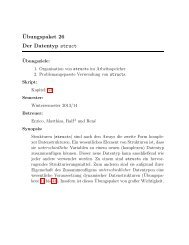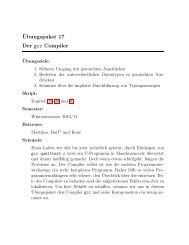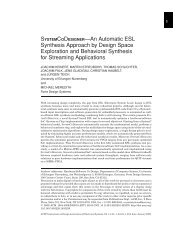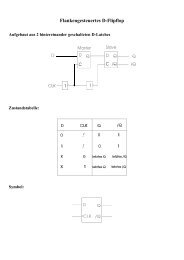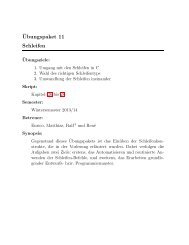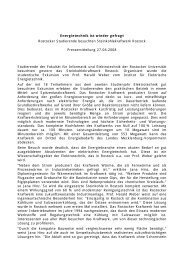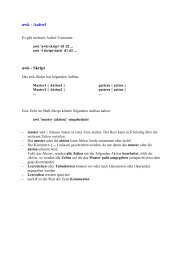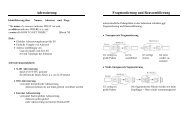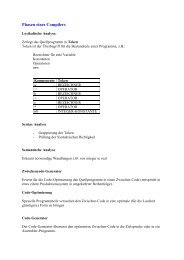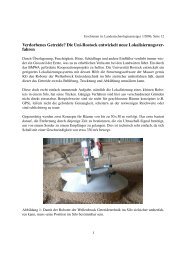Towards Robust Data Storage in Wireless Sensor Networks
Towards Robust Data Storage in Wireless Sensor Networks
Towards Robust Data Storage in Wireless Sensor Networks
You also want an ePaper? Increase the reach of your titles
YUMPU automatically turns print PDFs into web optimized ePapers that Google loves.
Siegmund N, et al.: <strong>Towards</strong> <strong>Robust</strong> <strong>Data</strong> <strong>Storage</strong> <strong>in</strong> <strong>Wireless</strong> <strong>Sensor</strong> Network<br />
sor network but is not mandatory for every node and<br />
even not for every sensor network. With FAME- DBMS<br />
(http://fame-dbms.org), we implemented such a customizable<br />
<strong>Data</strong>base Management System (DBMS) that<br />
can be used on embedded devices like sensor nodes [5].<br />
FAME-DBMS provides functionality required by<br />
larger data storage nodes of a sensor network as well<br />
as a customizable query <strong>in</strong>terface. This query <strong>in</strong>terface<br />
avoids any overhead by specify<strong>in</strong>g a tailor-made query<br />
language [6]. In order to <strong>in</strong>crease robustness of data storage,<br />
we propose to extend such a system by adopt<strong>in</strong>g the<br />
concept of RAID storage [7], known from server systems.<br />
The result<strong>in</strong>g data storage layer for WSNs can be used<br />
as the underly<strong>in</strong>g layer of our customizable DBMS to<br />
achieve distributed data storage. In comb<strong>in</strong>ation, we<br />
can provide the required data robustness and <strong>in</strong>tegrity<br />
necessary for future application scenarios of WSNs.<br />
2. Customizable <strong>Data</strong> Management<br />
Resource constra<strong>in</strong>ts and diversity <strong>in</strong> hardware of<br />
embedded systems force developers to create tailored<br />
software that provides only required functionality.<br />
Software Product L<strong>in</strong>es (SPLs) enable the development of<br />
software that can be customized to different use cases<br />
and application scenarios with m<strong>in</strong>imized development<br />
effort [8]. Products of an SPL differ <strong>in</strong> terms of selected<br />
features, i.e., the provided functionality. For example,<br />
one DBMS variant might provide a feature Recovery<br />
to recover data after failure. Another DBMS might not<br />
provide this functionality. The features of an SPL and<br />
relationships between the features are described <strong>in</strong> a<br />
feature model [9,10]. A feature model def<strong>in</strong>es if a feature<br />
is optional or mandatory as well as additional constra<strong>in</strong>ts<br />
between features, e.g., if a feature requires another<br />
feature. A typical visualization of a feature model is a<br />
feature diagram as depicted <strong>in</strong> Figure 1. Such a diagram<br />
is a hierarchical representation of all features of an SPL<br />
features, where the topmost feature, i.e., the root of the<br />
tree, represents the doma<strong>in</strong> concept. Features denoted<br />
with an empty dot are optional (e.g., feature Transaction<br />
<strong>in</strong> Figure 1), and mandatory features are represented by<br />
a filled dot (e.g., feature <strong>Storage</strong>). To derive a variant from<br />
an SPL, i.e., a concrete program, a stakeholder selects the<br />
features that fulfill her requirements and a composition<br />
mechanism is used to generate an executable application.<br />
2.1 Implementation Techniques for Customizable<br />
<strong>Data</strong> Management<br />
There are different approaches to implement software<br />
product l<strong>in</strong>es. Two prom<strong>in</strong>ent approaches are the C preprocessor,<br />
i.e., #ifdef statements of the C/C++ programm<strong>in</strong>g<br />
language, and composition of new variants based<br />
on components and frameworks. Both approaches have<br />
<br />
<br />
<br />
<br />
<br />
<br />
<br />
<br />
<br />
<br />
<br />
<br />
<br />
<br />
<br />
<br />
<br />
<br />
Figure 1: Excerpt of the feature diagram of FAME-DBMS.<br />
RAID features are currently not implemented.<br />
benefits but also deficiencies. For example, drawbacks of<br />
preprocessor statements are degradation of readability<br />
of the source code [11] and miss<strong>in</strong>g modularization of<br />
features, which raises problems <strong>in</strong> software evolution<br />
and even h<strong>in</strong>ders the elim<strong>in</strong>ation of dead features [12].<br />
Components, on the other hand, provide good separation<br />
of concerns [13]; however, the achieved customizability is<br />
usually limited to parts of a DBMS [14-16]. This is caused<br />
by crosscutt<strong>in</strong>g features that are scattered all over the<br />
entire DBMS, e.g., the transaction management system,<br />
which is hard to modularize <strong>in</strong> a component. Furthermore,<br />
very small components degrade the performance<br />
due to a communication overhead [3]. The result is an<br />
overhead not suitable for embedded systems especially<br />
for WSNs.<br />
In contrast to the C preprocessor and components,<br />
new programm<strong>in</strong>g paradigms such as Feature- Oriented<br />
Programm<strong>in</strong>g (FOP) [17,18] and Aspect-Oriented<br />
Programm<strong>in</strong>g (AOP) [19] are promis<strong>in</strong>g for implement<strong>in</strong>g<br />
SPLs. For example, Nystrom et al. used<br />
AOP <strong>in</strong> comb<strong>in</strong>ation with components to modularize<br />
crosscutt<strong>in</strong>g features that affect multiple other components<br />
[20]. Tešanović et al. used AOP to re-factor<br />
the C version of Oracles Berkeley DB to modularize<br />
crosscutt<strong>in</strong>g features that had been implemented with<br />
the C preprocessor before [21]. In the follow<strong>in</strong>g, we<br />
will focus on FOP s<strong>in</strong>ce it provides proper separation<br />
of concerns and at the same time also allows us to<br />
modularize crosscutt<strong>in</strong>g features.<br />
2.2 Feature-oriented Programm<strong>in</strong>g<br />
<br />
Feature-oriented programm<strong>in</strong>g (FOP) treats features of<br />
software as basic elements of the whole development<br />
process. It allows compositions of families of similar pro-<br />
<br />
<br />
<br />
<br />
<br />
<br />
<br />
<br />
<br />
<br />
<br />
<br />
<br />
<br />
336 IETE TECHNICAL REVIEW | Vol 26 | ISSUE 5 | SEP-OCT 2009




